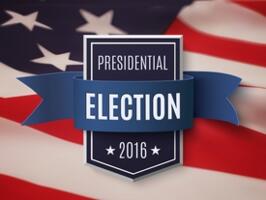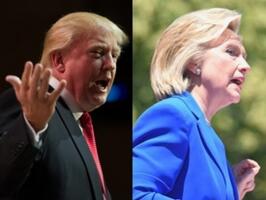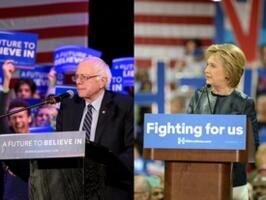The Undecideds Have It
A Commentary by Fran Coombs
Right now Donald Trump and Hillary Clinton are going nowhere.
Rasmussen Reports’ regular polling shows them both hovering around 40% support where they’ve been for weeks. Throw the most prominent third-party candidate in the mix, Libertarian nominee Gary Johnson, and they both drop only slightly.
In both matchups, though, there remain an unusually high number of voters who prefer some other candidate or are still undecided. Undecideds in single digits are not unusual at this stage of the election season, but when nearly one-in-four voters say they’ll vote third-party or stay home, it’s time to wonder why.
Are they really looking for another candidate? Are they still trying to make up their minds between Clinton and Trump? Or are they just not telling the truth?
(Want a free daily email update? If it's in the news, it's in our polls). Rasmussen Reports updates are also available on Twitter or Facebook.
In Clinton’s case, she still has a potent rival in Vermont Senator Bernie Sanders. That helps explain why 18% of Democrats favor some other candidate when given the choice of Clinton or Trump in our latest White House Watch survey. That compares to only eight percent (8%) of Republicans. It’s pretty safe to assume that many of those Democrats will break in Clinton’s favor once she’s the party’s official nominee.
At least that’s what Democratic voters say: 76% think a unified party is likely coming out of the Democrats’ national convention in late July, although that includes only 41% who say it’s Very Likely. Forty-six percent (46%) think Sanders is Very Likely to endorse Clinton.
Even if Sanders upsets Clinton in tomorrow’s California primary, party rules guarantee the former first lady the nomination, thanks to party insider superdelegates who don’t answer to the voters. But Sanders supporters, many of them young, enthusiastic voters critical to a Democrat win in November, already have shown that they’re not happy about this arrangement – or about Clinton. Keeping these young voters happy is one of the chief reasons we’re hearing increased talk of Elizabeth Warren as Clinton’s running mate, although it’s not clear why the Massachusetts senator would want to risk her ostensibly bright political future in such an uncertain election.
In short, Clinton has a very delicate line to walk between now and then, not least of which is determining how big a role Sanders will play at the convention and beyond. The further to the left Sanders pushes her, the more she is likely to upset blue collar Democrats already attracted by Trump’s message of economic nationalism. Big union leaders are already fearful about the divisions in their ranks.
Republican hopes that Clinton will be indicted for trafficking in classified information on a private e-mail server while secretary of State appear headed nowhere. Seventy-one percent (71%) of Democrats, in fact, think Clinton should keep running for the White House even if indicted until a court determines her guilt or innocence. The mind boggles at the thought of a newly elected president who has been indicted but whose trial would have to be put off until after she left office since presidents can only be removed through impeachment.
Trump, on the other hand, appears to be uniting Republicans, picking up an important endorsement last week from House Speaker Paul Ryan, the most powerful GOP congressional leader. The effort by a handful of conservatives to find a third-party candidate has become increasingly laughable, although it still generates plenty of media coverage.
Trump being Trump, however, he continues to make comments and generate headlines which make some Republicans uncomfortable. The media and his Democratic foes are strangely silent about the violent protestors attacking Trump supporters. But then 49% of voters believe most reporters are biased against Trump; only 18% believe most are biased against Clinton.
Whatever the cause, Trump continues to battle high negatives, and despite securing enough delegates to win the Republican nomination on the first ballot, news reports on his convention are sure to accentuate the negative. Meanwhile, his numbers like Clinton’s remain stagnant.
Clinton if she can emerge from her convention with a unified party is sure to make a dent in the number of voters who say they are looking for some other candidate. For Trump, the key to these voters is more speculative.
From general experience when we poll on highly controversial topics (e.g., a temporary ban on Muslims entering the country), it’s not unusual to see a higher number of undecideds. This suggests that many of these respondents don’t want to publicly state their position on this topic, fearful perhaps of being branded anti-PC, just to avoid controversy or maybe, who knows, because they think the NSA is listening in. It wouldn’t be surprising if many voters regard support for Trump that way: It’s the topic you don’t bring up at the dinner table because you don’t want to argue.
In addition, many of Trump’s supporters have demonstrated their suspicion of the media and the political establishment in general. Is there a “silent majority” out there waiting to vote for Trump? Republicans certainly hope so.
It’s a 40-40 logjam. Which of the candidates is going to start breaking away, and when?
Fran Coombs is the managing editor of Rasmussen Reports.
See Other Political Commentaries .
See Other Commentaries by Fran Coombs .
Views expressed in this column are those of the author, not those of Rasmussen Reports. Comments about this content should be directed to the author at fran.coombs@rasmussenreports.com.
Rasmussen Reports is a media company specializing in the collection, publication and distribution of public opinion information.
We conduct public opinion polls on a variety of topics to inform our audience on events in the news and other topics of interest. To ensure editorial control and independence, we pay for the polls ourselves and generate revenue through the sale of subscriptions, sponsorships, and advertising. Nightly polling on politics, business and lifestyle topics provides the content to update the Rasmussen Reports web site many times each day. If it's in the news, it's in our polls. Additionally, the data drives a daily update newsletter and various media outlets across the country.
Some information, including the Rasmussen Reports daily Presidential Tracking Poll and commentaries are available for free to the general public. Subscriptions are available for $4.95 a month or 34.95 a year that provide subscribers with exclusive access to more than 20 stories per week on upcoming elections, consumer confidence, and issues that affect us all. For those who are really into the numbers, Platinum Members can review demographic crosstabs and a full history of our data.
To learn more about our methodology, click here.




